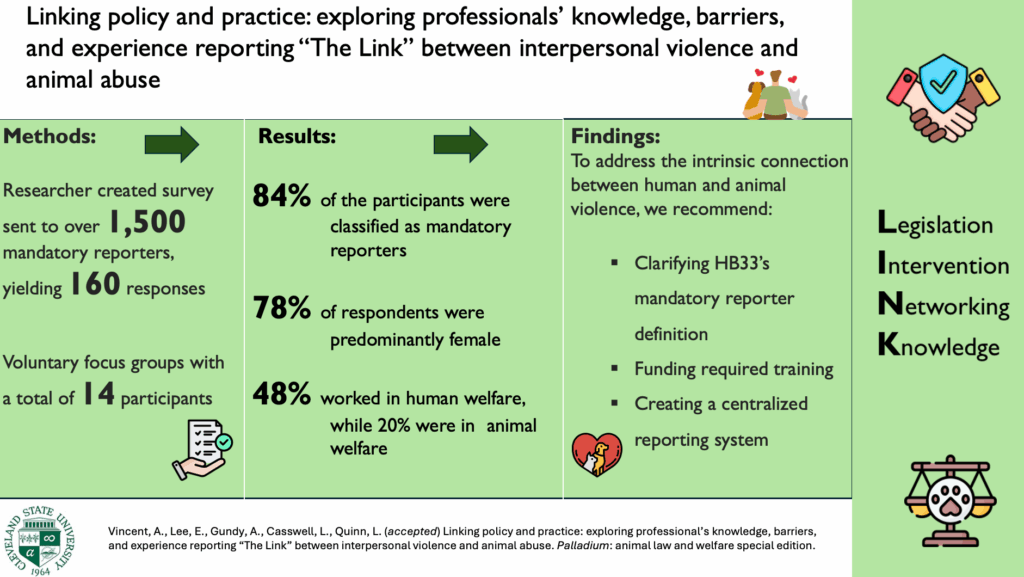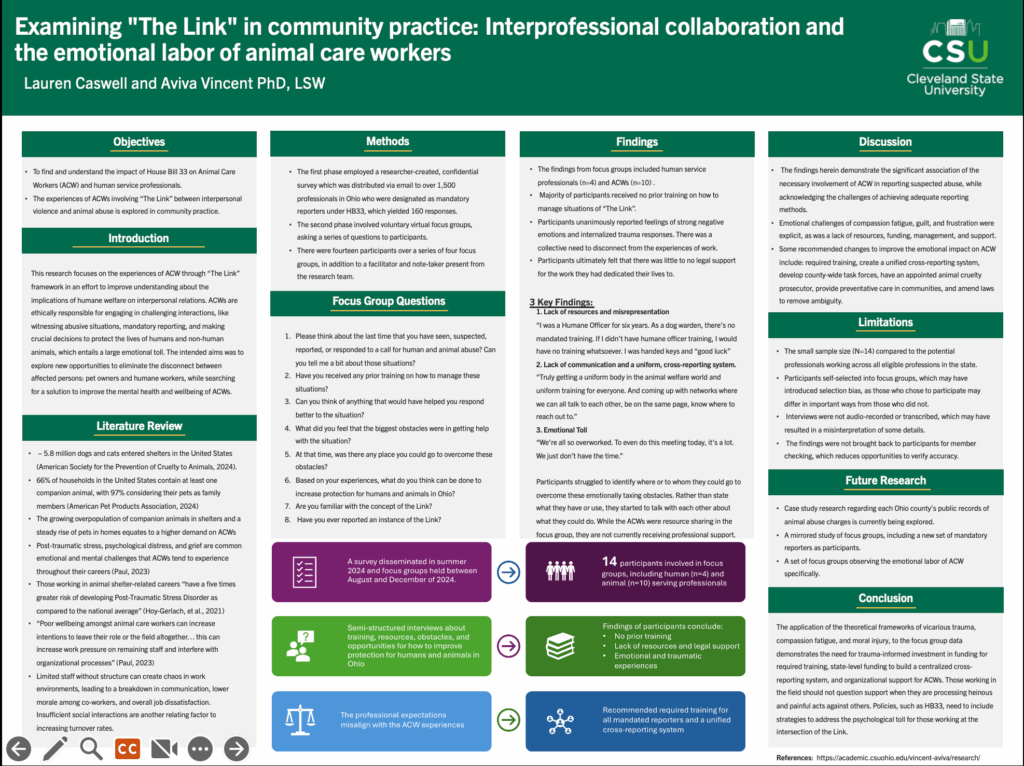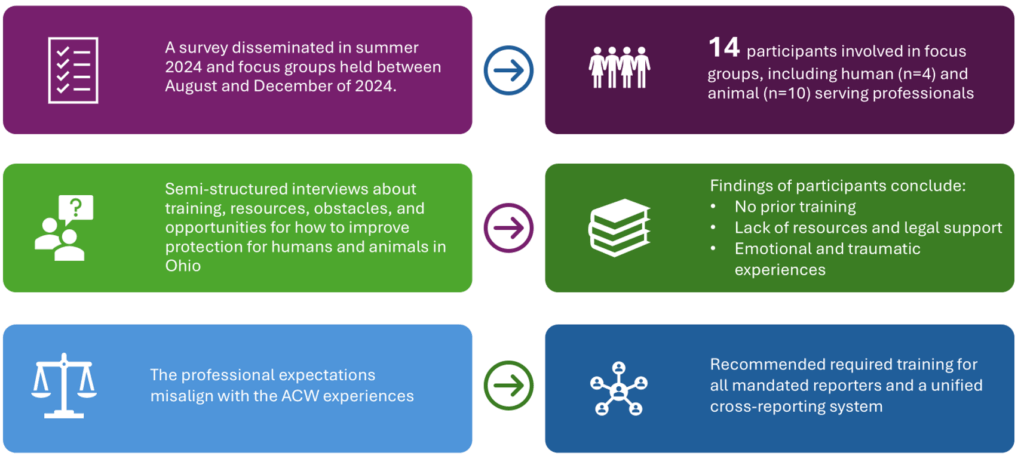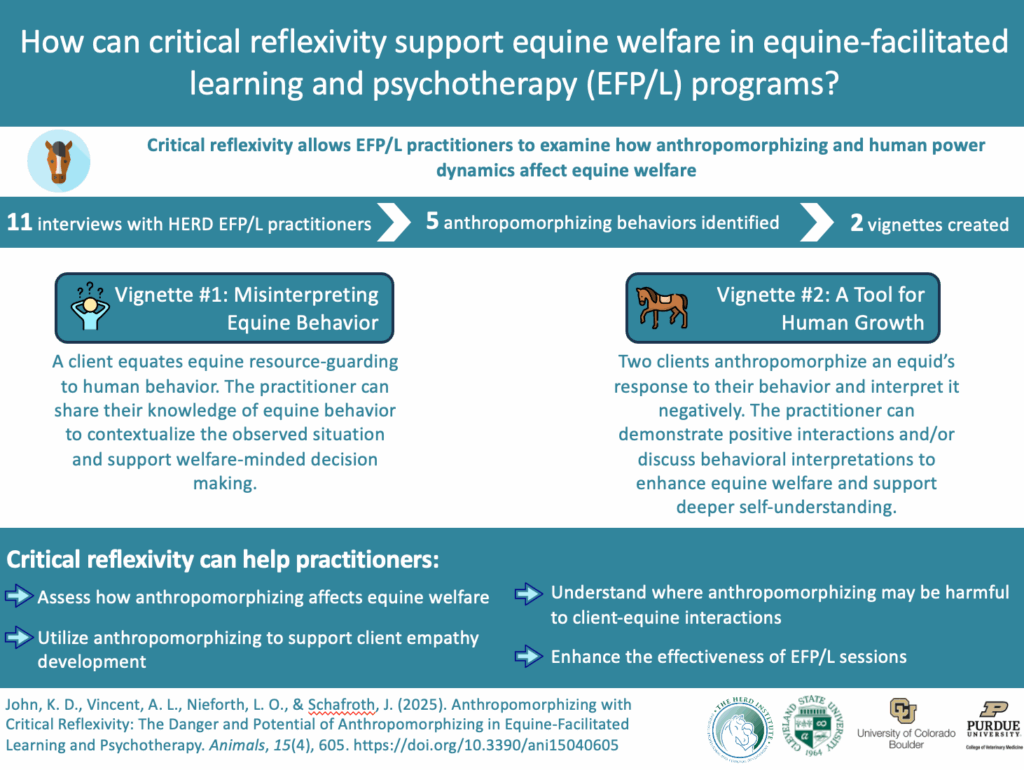Linking policy and practice: exploring professional’s knowledge, barriers, and experience reporting “The Link” between interpersonal violence and animal abuse

Examining “The Link” in community practice: Interprofessional collaboration and the emotional labor of animal care workers
Examining “The Link” in community practice: Interprofessional collaboration and the emotional labor of animal care workers
Lauren Caswell & Aviva Vincent, PhD

Abstract
This research focuses on the experiences of Animal Care Workers through “The Link” framework, which refers to The Link between interpersonal violence and animal abuse, in an effort to improve understanding about the implications of humane welfare on interpersonal relations. The intended aims were to explore new opportunities to eliminate the disconnect between affected persons: pet owners and humane workers. Researchers administered an open community survey to professionals across human and animal service fields, offering participants the option to join semi-structured focus groups. These conversations invited participants to share their experiences related to abuse recognition, response practices, knowledge of The Link, and the extent of cross-reporting behaviors. Participants voiced their struggle with their perceived lack of professional support, such as confidence in whom they could go to overcome these emotional-taxing obstacles. However, the participants demonstrated their emotional resiliency by turning the semi-structured conversation to opportunities, such as creativity with resources, forming a community of support, identifying a mentor, contacting a special animal law prosecutor for guidance, or going to the Dog Warden Association for help. Applying the participant’s identified opportunities to the policy recommendations of HB33, and current community practices provides a framework for future training, collaborative practice, and legislative mandate(s). ACWs require professional support to improve their mental health and wellbeing. There are a plethora of opportunities to reduce interprofessional tension, with the most pragmatic being a state-wide required training for all mandatory reporters on the concept and importance of recognizing and reporting The Link.

References
American Pet Products Association. (2024). The American Pet Products Association (APPA) releases 2024 Dog and Cat Owner Insight Report
American Society for the Prevention of Cruelty to Animals. (2024). U.S. animal shelter statistics. https://www.aspca.org/helping-shelters-people-pets/us-animal-shelter-statistics
Hoy-Gerlach, J., Ojha, M., & Arkow, P. (2021). Social workers in animal shelters: A strategy toward reducing occupational stress among animal shelter workers. Frontiers in veterinary science, 8, 734396.
Paul, N. K., Cosh, S. M., & Lykins, A. D. (2023). “A love–hate relationship with what I do”: Protecting the mental health of animal care workers. Anthrozoös, 36(3), 489–508. https://doi.org/10.1080/08927936.2023.2166712
Anthropomorphizing with critical reflexivity: The danger and potential of anthropomorphizing in Equine Assisted Services

Bridging Campus Police and Community with Therapy Dogs
Man O’war Project PTSD-Equine Assisted Assisted Therapy Project: Mixed Methods Findings from a Fieldsite
While there are many programs exist that support Veterans through wellness, well-being and social/peer support, the rate of Veteran suicide is still unacceptable, between 22 and 44 deaths by suicide and/or self-injury daily. The demand for Equine Assisted services (EAS) has increased exponentially, however, the research is just beginning to take rigorous steps in methodology. There is no existing standard of practice, defined certification required, or accessible (financial or regional) training for practitioners, nor a unified manual, protocol, or curriculum. The Man O’War Project (MoW Project) partnered with Columbia University to create and test a standardized curriculum that could be disseminated to other trained professionals, delivered universally, in an accessible format. The initial study objectives sought to explore: novelty, fidelity, and mechanisms of change. The second iteration of this study was to recruit teams of credentialed professionals to attend a training to learn to deliver the curriculum. This poster presents findings from the training and curriculum delivery to Veterans, focusing on client process and well-being outcomes.
The program consisted of Licensed Mental Health Clinicians and Equine Specialist trained in the curricula, horses, and Veterans as participants (N=14). The program was offered weekly for 8-weeks to groups of up to six Veterans working from the ground with horses in partnership. Using a strengths-based approach, the Veterans were tasked with activities to move through the concepts of increasing social-emotional skills, recognizing emotions, goal setting & problem solving, and self-regulation. Groups took place between July and September 2023. Participants were predominantly male (n=11), white (n=11), and ranged in age from 35-85 with no dominant age range. Veterans completed the PCL-5 pre/post intervention and a program evaluation questionnaire. All data was de-identified and provided back to PATH Intl to be used in aggregate with other Centers providing this program.
Veterans attended an average of 6.25 sessions out of the eight sessions offered. They self-reported enjoyment of all core activities, though leading with the most highly rated. Veterans’ perceptions of the intervention was that their anxiety decreased, they bonded with the horse, improved their mindfulness, and increased their confidence. Interestingly, participants shared that they were triggered by the name of the project as they did not identify as a “Man O’War ” and were not familiar with the racehorse by the name. Post-assessment scores on the PCL-5 decreased from above the clinical range for PTSD to below. All measures of the sub-scales (hypervigilance, negative thoughts and beliefs, avoidance and flashbacks) decreased from the pre-intervention to the post-intervention. While not significant, the total score change from pre to post had a moderate effect size (Cohen’s d=.43).
Conclusion: These findings validate the on-going research to implement this study at additional PATH Intl Centers. The qualitative feedback from the Veterans supports that the horses provide a present point of connection that has been echoed in the research for decades. The potential implications for practice include a valid and reliable training and protocol for providing EAS to Veterans.
More about Man O’War: https://mowproject.org/
Music Therapy Research
Bringing adaptive riding and music therapy together, Fieldstone Farm TRC has been facilitating this innovative collaboration for nearly ten years. Though the organizational partnerships have changed over the years, the love of music in therapeutic riding has been consistent. The goals of therapeutic riding and music therapy are very similar: actively engage students and regulate sensory needs; increase entrainment (the brain’s ability to “sync up” with an external rhythm, be it music or horse); increase automatic or spontaneous speech; prevent unsafe behavior; and encourage relaxation/enjoyment.
To assess what is happening in therapeutic riding lessons with music therapy, a research team observed two lessons occurring simultaneously – one with adaptive riding only, and one with music therapy and adaptive riding. The aim was to observe change within each group and compare to each other. The outcomes being observed were: focus/attention to task; positive engagement between peers, volunteers, and instructors; proper riding technique; and self-regulation.
In the intervention group, examples of how music was used include:
Concept Recognition: The “Walk On” song was used to provide musical cues for the students. This helped them to understand and predict when the “Whoa” cue to stop was coming.
Engagement: The music therapist used musical elements such as rhythm, pitch, and dynamics as a cue for tasks/activities
Focus on task: The music therapist would act as a moving target for students who needed to watch where they were going/look at what was in front of them.
Safety: Providing musical cues for safety and riding techniques.
In the pilot study, students attended 83%-100% of sessions; no student missed more than one session. All students rode for the full 45-minute lesson. Overall, the students from the therapeutic riding only group improved consistently over time with improvement by the majority of the students in five of the six sessions. In the music therapy group, students were successful in recalling information learned through music experiences week to week and demonstrated increased understanding of what they learned as expressed by being able to fade prompts and cues. For example, volunteers shared that the student sang the “Walk on/Whoa” song independently and quietly to themselves while riding their horse, using the concept song as personal reminders. Students benefited from music therapy support as co-treatment alongside therapeutic riding.
Research is continuing in 2024 to observe a new cohort of riders to grow the sample size, resulting in more data, with the aim of being able to assess impact with more rigorous methods.
